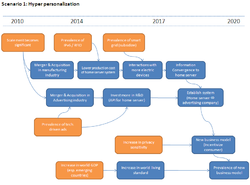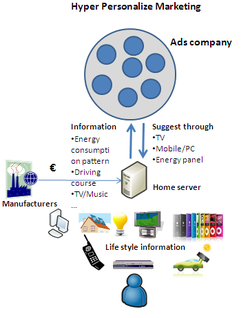Scenario 1: Hyper Personalized age
Description(!Work in progress!)
2010 - 2013: Merger and Acquisition for an expansion of scale and technology
As world economy becomes globalized, the scale has been a critical factor for corporations to win in the market. Complying with this trend, corporations in varied industries accelerate the merger and acquisition strategy to achieve the scale merits. In manufacturing industry, corporations accomplish the lower production cost and more competitive sales and procurement channels, consequently lowering the product price. In advertising industry likewise, numerous integrations are observed. In addition to the scale merit, advertisement companies attempt to acquire the key technology to prosper in the future market as advertising revenues are shifting from mass marketing to marketing one on one. Google’s adwords are the role model for other media companies and the holy grail for TV broadcasters who becomes more and more desperate to keep advertising revenues coming in. Especially TV realize that target advertising is am must to survive as advertisers demand metrics if the consumers actually watch an advertisement even if they watch the TV show it was associated with. Ad skipping technologies such as personal video records are now mass market in developed countries and upper middleclass in emerging markets such as India and China which puts further pressure on innovation and business model changes in the media market. Pay-TV operators with vertical business models, e.g. they own the set-top-box and the software that controls the user interface are at an upper hand here as middleware companies race to have target advertising supported technologies available to their customers distributing digital content over any network.
At the same time the print media are successfully changing its distribution model from physical distribution to digital distribution to dedicated digital reading devices. This gives the opportunity for the print media players to measure how many actually read a certain page and advertising and as telescoping is now possible on reading devices a second metric is possible as you can now see how many subscribers actually accessed a more content rich version of the advertisement. , Digital reading devices are now highly personal like mobile phones which solve a lot of the problems with shared computers and set-top-boxesas you will not know exactly who is an household is consuming the content. The DLNA home networking standard is beginning totake off and becomes more and more the global home networking standard.
2014 - 2016: Prevalence of technology to store personal information
More intense R&D investments and higher efficiency generated through the merger and acquisitions in manufacturing industry results in prevailing varied new technologies that influence advertising business. IPv6 technology, which had been established for many years but not been commercialized due to the high production cost, is a good example. With IPv6, we can allocate IP address to electric devices at home and allow them to communicate each other. The technology potentially impacts on advertising industry since it stores the consumers’ life style information with which advertisers can directly deliver more advertisements matching each consumer’s interest. (See scenario 2020 for details) The lower production cost allows manufactures to embed IPv6 technology in their wide range of product line. Concurrently, home server system which manages electric devises at home while centralizing the personal log information stored each device also starts being prevailed. Furthermore, under the post Kyoto protocol, governments introduce to households the smart grid technology that manages the home electricity utilization through its subsidizing policy. Smart grid can also send to the home server the consumers’ life style information such as the time they wake up and sleep or the time they cook or take a bath. Consumer electronics vendors embrace the green agenda and help to speed up the environmental thinking on electricity consumption.
The spread of home networking and the global adoption of DLNA by all the global consumer electronics vendors help to speed up the adoption rates and force the content aggregators and distributors to implement consumer oriented business models. The line between the internet and TV is now almost erased as in all developed economies IP is the only real delivery methods for video and audio content. This open doors for the advertisers and they can now get user metrics on video distribution as IP is a two way connection compared to broadbast TV which require a telephone modem back channels. With two connectivity advertiser can finally take advantage of the various content distribution networks which gives the intenet players a slightly weaker position as the pay-TV platforms and broadcasters who previously lost out to the internet players are now gaining groud as they have large concentrated groups of customers suitable local and tailored advertising.
Telecommunications and broadcasters have an upper hand here as they have had a billing relationship with their customer for a long time as triple play has existed for 15 years by now. They have collected a lot of user data via different channels already anticipating the need to do so which makes them very powerful in the era of IP distribution, the one who control the consumer data are in the most powerful situation in this scenario. To some extent the operators are the one that have access to the database that used to be controlled by market researchers. Internet players, telcos and operators are seeking partnerships with market research companies, technology providers, credit card companies and mass retailers to build very powerful solution to track advertising consumption down to consumption. For example, players like Procter and Gamble are very willing to spend loads of money on a campaign where they target home servers within a specific postcode, and then retail loyalty cards and credit cards used to pay for this specifc product will tell Procter and Gamble if their advertisement had the necessary return on investment. Consumer electronic devices added to the home network are now getting into the white goods are after only having been limited to media and entertainment.
2017 - 2020: New business scheme opens the door to new advertising age
Advertising companies with advanced IT competence developed the technology that interacts with home servers in each household. Through the system, the advertising companies are able to take in consumers’ personal information, including TV programs they watch, food stock in refrigerator, music they play, web sites they visit and so on, accurately analyze the personal interests and deliver the appropriate advertisements. (See scenario 2020 for details) As a consequence we see heavily subsidized hardware via network operators, since advertisers now see the benefit of having controlled devices in every home. The network operator’s benefit from this as they in the past had to invest heavily in device subsidies and now the big advertisers are flocking to help them accelerate the technology upgrades.
However, increasing sensitivity to consumer privacy and critics from consumer organizations inhibit advertising companies from promoting the system. In a mean while, advertising companies overcome this situation with new business scheme where consumers are financially incentivized by providing their personal information. Consumers can receive adequate monetary value from advertising companies or obtain a high spec home server system for free in exchange of their personal information.
For example, Procter and Gamble provide a digital point scheme that adds up on your credit card or local grocery loyalty card. When you do your shopping your are given special offers as you enter the shop via location based services to your mobile phone or via the digital scanner on your shopping cart, as manual check-out at supermarkets does not exist anymore.
2020: Hyper personalized age
As a result, more than 65% of consumers operate the home server under the incentive scheme provided by network operators and the advertising industry. Home servers manage almost all of the electric devices in the home ranging from TV to music players, PC, mobile phones, automobiles, refrigerators, cooking system and smart energy system. Strong economic growth especially in emerging markets further encourages the penetration of home server systems and new business models. Now, advertising companies can deliver the right advertisements at the right time to the right place. Personal information in the home server provides the highest degree of personal interests based on which advertisers can identify the most suitable advertisements. By having mobile devices such as phones or media players connected with the home server all the time and by location based services real-time interactions with home servers allow advertising companies to select the most effective timing to send the advertisements, as it now becomes possible to target individuals passing a specifc brand retail store or shop, as all devices have GPS trackers in them. In particular, advertising companies are able to deliver the football shop advertisements to those who spend more than 2 hours on watching foot ball matches per week and display them on the TV screen when they are actually watching matches on TV. Additionally, after analyzing the foods stock information from the refrigerators, advertising companies also send to the vehicles the grocery shop advertisements, showing foods necessary to buy, when consumers are driving back home from the office.
Driving Forces(!Work in progress!)
Economy
- Scale merit
- Increase in world GDP
Technology
- IPv6
- Smart grid
Policy
- Sustainable policy
Society
- Privacy Tradeoff information- a balance trick
Questions
- What technology will store personal information?
- Does any sustainable policy affect advertisement?
- How does the economic downturn influence advertising industry?
- How is the advancement of technology damaging consumers' privacy?
- How is the consumer reacting to it?
- What is internet privacy?
- What is current privacy issue?
- What is behavioral Advertising?
References
- Center of Democracy & technology: http://www.cdt.org/privacy/guide/debates.php#consumer
- http://smartgridcity.xcelenergy.com/learn/downloads.asp
- http://www.nema.org/gov/energy/smartgrid/
- http://startuptrek.net/smart-grid-top-level-architecture/
- http://en.wikipedia.org/wiki/Smart_grid
- http://roy.gbiv.com/untangled/2008/economies-of-scale
- http://en.wikipedia.org/wiki/Economy_of_scale
- http://www.economywatch.com/gdp-growth/world-gdp-growth/
- http://www.economywatch.com/world_economy/world-economic-indicators/world-gdp.html
- http://www.bloggingstocks.com/2008/06/10/world-bank-cuts-2008-global-gdp-growth-forecast-due-to-oil-food/

